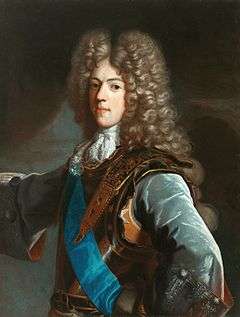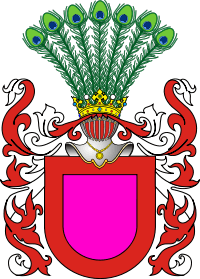Konstanty Władysław Sobieski
Konstanty Władysław Sobieski (1 May 1680 – 28 February 1726) was a Polish prince, nobleman, politician, diplomat, scholar and the son of John III Sobieski, King of Poland, and his wife, Marie Casimire Louise de la Grange d'Arquien. In 1708 he married Maria Józefa Wessel.[1]
Konstanty Władysław Sobieski | |
|---|---|
| Prince of Poland | |
  Portrait by Hyacinthe Rigaud | |
| Born | 1 May 1680 Warsaw, Poland |
| Died | 28 February 1726 (aged 45) Żółkiew, Poland |
| Family | Sobieski |
| Father | John III Sobieski |
| Mother | Marie Casimire Louise de la Grange d'Arquien |
| Religion | Roman Catholicism |
Early life and career
Konstanty Władysław Sobieski was the youngest son of John III Sobieski. His first tutor was Karlo Mauricio Vota, a Jesuit. Later his teacher became Remigian Suszycki from the University of Cracow and "chevelier de Neufmaison", who taught him about military. Konstanty also learned Italian and French.
After the king’s death, he almost always accompanied his mother and brother Aleksander Benedykt. In 1698, after the division of his father’s estates, Konstanty received, most notably, the Żółkiew property, Wilanów Palace and the Kazimierz Palace in Warsaw. In the course of her stay in Rome, queen Marie Casimire planned to obtain a cardinal’s hat for Konstanty. Her intentions were thwarted by the uninhibited behaviour of the prince who, while visiting his mother in 1701, got involved in an affair with Tolla, a Roman beauty also adored by Duke Gaetan Sforza, who wounded her in front of the Sobieski mansion, a deed for which he later formally apologised. In the first years of the Great Northern War, Konstanty supported his brother Jakub’s attempts to mount the throne of Poland. In February 1704 both brothers were kidnapped and incarcerated by Augustus II the Strong. In 1706 they were set free by the victorious Charles XII of Sweden.[2]
Politics, romances and later life
In November 1708 Konstanty unexpectedly married, in Gdańsk, Maria Józefa Wessel, whom he probably knew from childhood. He presented his bride with a life estate contract, considerably hindering the subsequent attempts of the Sobieski family, which perceived the relationship as a misalliance, to annul the marriage. The prince had already abandoned his wife by December, leaving her in Gdańsk, and in the spring 1709 he accompanied Stanisław I to the Lwów region, where he met Elżbieta Sieniawska, a hetman’s wife, who believed that in the prevailing political situation Konstanty’s election would be preferable to Augustus II returning to the throne. In subsequent years, the prince often stayed on his brother’s estates in Oława, Wrocław and Żółkiew.[3]
Death
Suffering from rheumatism and seriously indebted, in 1725 Sobieski unexpectedly made amends with his wife, who offered him financial aid and brought him from Wrocław to Żółkiew, where he died and was buried in the parish church. The Żółkiew residence owes to Sobieski its impressive painting collection and abundant library.[4]
Ancestors
| Marek Sobieski | |||||||||||||||
| Jakub Sobieski | |||||||||||||||
| Jadwiga Snopkowska | |||||||||||||||
| Jan III Sobieski | |||||||||||||||
| Jan Daniłowicz | |||||||||||||||
| Zofia Teofila Daniłowicz | |||||||||||||||
| Zofia Żółkiewska | |||||||||||||||
| Konstanty Władysław Sobieski | |||||||||||||||
| Antoine de La Grange d'Arquien | |||||||||||||||
| Henri Albert de La Grange d'Arquien | |||||||||||||||
| Anne d'Ancienville | |||||||||||||||
| Marie Casimire Louise | |||||||||||||||
| Baptiste de La Châtre of Bruillebault | |||||||||||||||
| Françoise de La Châtre | |||||||||||||||
| Gabrielle Lamy[5] | |||||||||||||||